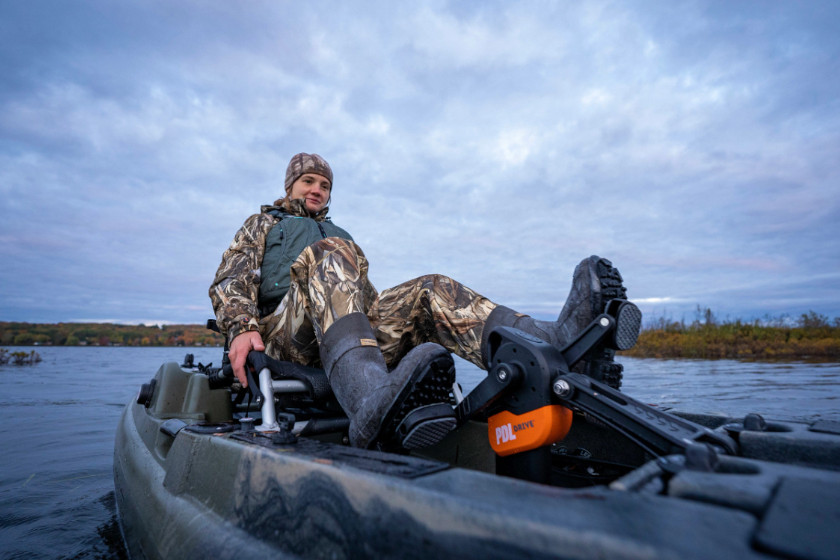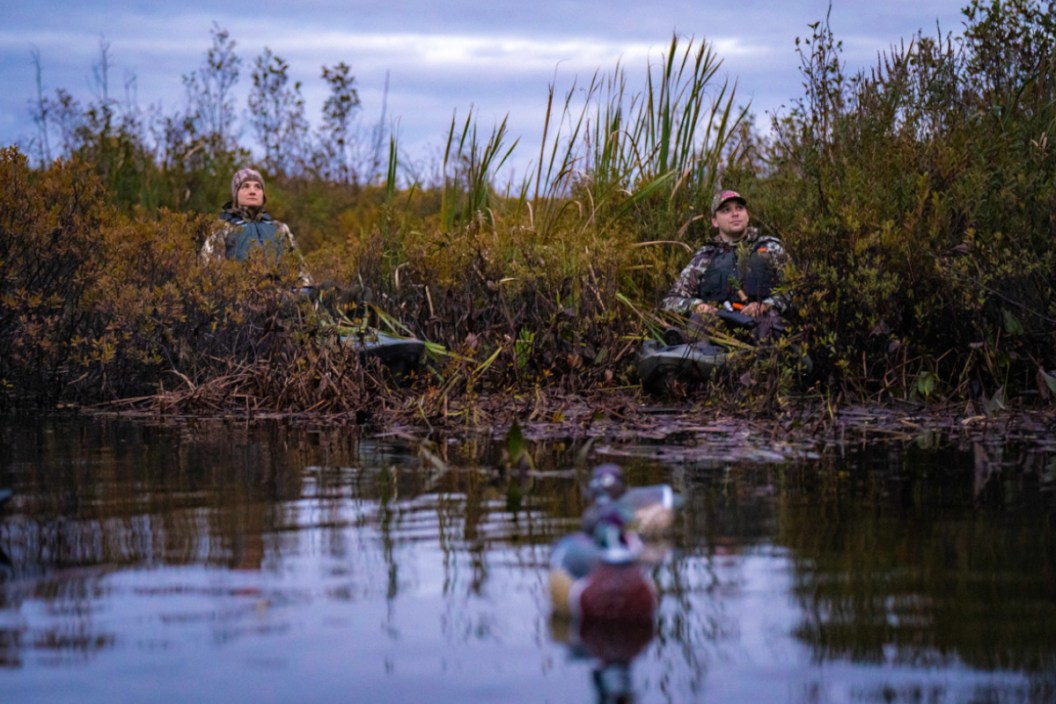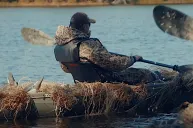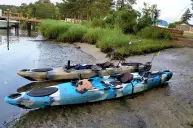These are the things to think about when rigging your kayak or canoe for waterfowl.
In the world of hunting, it seems like everything that is old comes back around to be new once again. While there's often a huge push for the next big thing, many hunters are discovering some of the old ways of doing things work pretty darn well too. Such is the case with using canoes and kayaks for waterfowl hunting. This kind of small watercraft took a back seat for the latest and greatest in motorboat technology a long time ago.
According to Johnson Outdoors' Alex Sherbinow, kayak duck hunting is making a comeback. Beyond just being a more cost-effective method, it may simply be a better way to hunt overall.
Sherbinow and I talked about some of the best ways for duck hunters to rig up their kayaks for waterfowl hunting season. I learned that these smaller crafts can give hunters a huge advantage over the men and women using larger, more expensive boats.
"It's coming back into trend."

Scott Niska/Johnson Outdoors
"People have been using canoes and kayaks to duck hunt for generations. It's not a new thing," Sherbinow told me. "Kayak hunting's coming back into style in my opinion, but there's always been this small niche of hunters who use canoes and kayaks."
Sherbinow is the Marketing Manager for Johnson Outdoor Watercraft. They manufacture the popular Old Town series of kayaks, including the Discovery 119 Solo Sportsman hybrid kayak/canoe and the Sportsman Big Water sit-on-top kayak. While many of the company's boats are fishing kayaks designed for anglers, Sherbinow has noted a resurgence in interest in using these small vessels access untouched hunting spots that Jon boats and other larger watercraft simply cannot reach. That's a good thing for hunters, especially in modern times where more folks than ever are looking to stick to a budget and need to save some money on outdoor recreation setups.
"I think that's the beauty of kayak hunting," Sherbinow said. "You don't have to have a fancy blind. You don't have to spend a thousand dollars to rig out your kayak."
Even if you do have the funds for a larger boat, you might still want to consider a kayak or canoe because of the versatility and maneuverability of the small craft. Since he started seriously using a kayak for duck hunting approximately eight years ago, Sherbinow has come to love all the benefits of being able to paddle into the shallow water of a marshy river's backwater, where the depth might only be three inches.
The low profile of a kayak allows him to get into tiny, tucked-away ponds near agriculture fields and food plots where other hunting boats cannot go. In turn, this has led to increased sightings and greater harvests each year.
"It's pretty rare that I will go in for a hunt and see anyone, let alone a boat," Sherbinow said. "Usually, the competition are the people walking the banks, or tucking in and hunting from the edge of the water."
Additionally, the use of a paddle or simple trolling motor lets him to sneak into his spots quietly in the pre-dawn darkness, allowing him to ambush birds in places they may have never previously associated with danger.
"It truly allows you to get to places no one else can, and places that hold a lot of birds, especially during the peak of the season when there's a duck boat on every corner," he said.
Things to Consider in a Hunting Kayak

Scott Niska/Johnson Outdoors
Anyone who has ever fished in a kayak probably knows the largest downside: a lack of space to hold all your gear. Sherbinow said potential kayak owners should look closely at the weight capacity of the craft and factor in not just their bodyweight, but also the weight of their decoys, firearm, hunting blind, and hunting dogs that may accompany them.
He notes that the Old Town Discovery 119, which is a sit-in style canoe, was specifically designed for tasks like this. The hull design makes it look like a smaller canoe, but it tracks like a kayak in the water, bringing hunters the best of both worlds. Sherbinow regularly uses the Big Water series too, but preferences will depend on what each hunter is most comfortable using.
3 Keys to Rigging a Hunting Kayak
Sherbinow has three key things he thinks about when rigging a kayak or canoe for waterfowl. They are safety, accessibility, and concealment.
To address the safety factor, the first thing he thinks about are lights. If you're crossing open water in the pre-dawn hours, small lights are a must, and not just for lighting the way.
"Lighting is critical, especially on open water where there are boats flying around, or in the river where you take a wrong turn and end up in 10,000 different potholes and get lost," Sherbinow said.
That's why his first modification to any boat is to make sure it has an adequate lighting system. A light that faces forward is a must for when you're navigating a thick, swampy marsh and need to move through sunken timber, shallow grasses, and beaver dams in the darkness.

Scott Niska/Johnson Outdoors
Second is accessibility. More specifically, Sherbinow wants to keep everything from his firearm to his decoys secure in case he needs to get out of the boat in a hurry. He has an enter and exit strategy for the boat at all times.
"There's a lot of times when I'm traveling into the marsh and I get hung up on a stump and I need to jump out of the boat really quickly, drag it over a beaver dam, or whatever it is," he said. "If you don't think through how you're going to get in or out of your boat, you open yourself up to a lot of risk."
Sherbinow notes that keeping your firearm secure while paddling is also extremely important. He highly recommends buying a floating gun case to protect your expensive firearm in case it gets knocked overboard, or if you end up accidentally flipping the kayak. Most kayaks these days offer excellent stability, but it's better to be safe than sorry. Sherbinow notes he's also used paddle holders to secure his shotgun's barrel in a safe direction. He said Yak Attack paddle holders can be quickly adapted for this task.
The last thing to consider is concealment, which deserves its own section to fully address it.
Concealment for a Hunting Kayak

Scott Niska/Johnson Outdoors
No matter what type of craft you are using, concealment is extremely important to find success while using a kayak or canoe. In fact, how well you hide your boat and yourself may make or break your next waterfowl hunting trip.
"If a duck's flying over you, and they see a little bit of black, or the wrong shade of grass, that can be enough to make them fly away," Sherbinow said. "That can turn it from a record day, to one where you go home empty handed."
In most instances, Sherbinow is not even using a blind. This is where kayaks have distinct advantage. Sherbinow usually just paddles into the reeds and bends some branches over his boat for concealment. The small size makes this technique easy and fast. He can then hide among the grasses himself without the need for a blind. It's yet another budget-friendly way kayaks can help hunters; it doesn't take much to find success using this method.
"I would highly recommend using the natural elements around you," Sherbinow said. "You don't always need to have crazy blinds."
While plenty of boats (and even some kayaks) come covered in a camo pattern, it can make things difficult if you're hunting a variety of scenarios and the camo does not match the spot you're hunting. That's why Sherbinow likes to rely more on the vegetation around him to break up the outline.
"You can be hunting woods one day, and marsh grass the next," Sherbinow notes. "From flooded timber to marsh grass, you're going to have totally different camo styles."
That's not to say you cannot outfit your kayak with a hunting blind. In fact, it's something that Sherbinow has started to experiment with. He's had a lot of success using a Cabela's Northern Flight Kayak Blind, which essentially turns a kayak into a layout blind with few modifications.
"It takes a little bit of adjustment to make it match up with whatever boat you're in," he said, "but it's really nice that it's designed for those platforms."
He did note he often removes the padded seat from the kayak when installing one of these blinds simply because it makes it easier to install. If you're hunting in waders using natural concealment, you can leave the seating system in place.
Dealing with Decoys

Scott Niska/Johnson Outdoors
Probably the biggest challenge for any waterfowler is figuring out how they are going to transport those vital decoys to their hunting spot. This is an area where Sherbinow likes to break from tradition, and it's revealed another benefit of the kayak hunter.
"Usually, I'm trying to keep my decoy spread between 18 to 20 decoys," he said. "That's because I think waterfowl hunters are throwing out mega spreads of decoys, and it's not necessarily realistic, especially in the early season."
Even if he does bring more, he usually does not have more than 24 to 30 out at a time. That should be taken as good news for beginners or hunters on a budget. For a smaller setup, there's usually plenty of room to haul that many along with your additional hunting gear. Sherbinow has had great success getting birds to buzz these smaller setups that he's started to forget about the larger ones.
Sherbinow likes to use Texas-rigged Flambeau decoys, not just because they're durable and effective, but also because the Texas-rig style allows him to clip all the decoys together and haul them easier. Whether he's using the Discovery Solo 119, or the BigWater, he likes to stow them behind him in the rear of the craft. In the 119, the decoys pack nicely into the canoe-like storage space. On the BigWater sit-on-top, he uses the included bungee cables to secure them. On the off chance he does need more decoys, he usually places them over his legs.
Paddle, Pedal, or Trolling Motor?

Scott Niska/Johnson Outdoors
Once again, this is where kayaks and canoes offer a great deal of versatility. Sherbinow often uses his Discovery 119 with a trolling motor, which has become his preferred setup while navigating open water. He also likes to use a pedal drive system in similar situations, but he did note that another benefit to choosing a pedal kayak is you can remove the pedal system and simply operate it like a normal kayak.
For rivers, he finds himself paddling more than not, mainly because this gives the kayak a shallower draft and allows him to reach those remote, shallow pools that other hunters can not reach.
Whether you opt for a trolling motor, pedal power, or simply paddle, kayaks and canoes are great for duck hunting. Using them in areas with highly pressured waterfowl allows hunters to slip in silently under the cover of darkness and get setup without the birds knowing. Compare that to the noisiness of an outboard motor and the echoing sounds of hunting gear rattling on the bottom of a metal Jon boat, and the advantages become clearer.
Add in the ability to endlessly customize your craft to your style of hunting on the cheap, and kayaks make for an extremely affordable option to get started in waterfowl hunting. To learn more about the Old Town Sportsman BigWater and Discovery Solo 119 watercraft, you can visit the Old Town website.
For more outdoor content from Travis Smola, be sure to follow him on Twitter and check out his Geocaching and Outdoors with Travis YouTube channels.
NEXT: 5 BEST DUCK HUNTING KAYAKS AND CANOES FOR THE UPCOMING SEASON
WATCH




